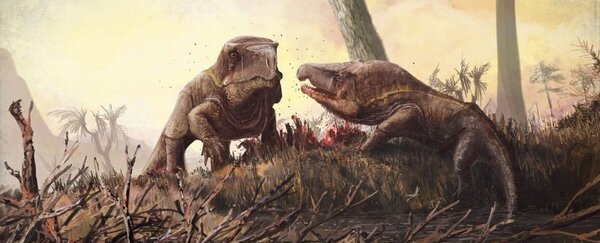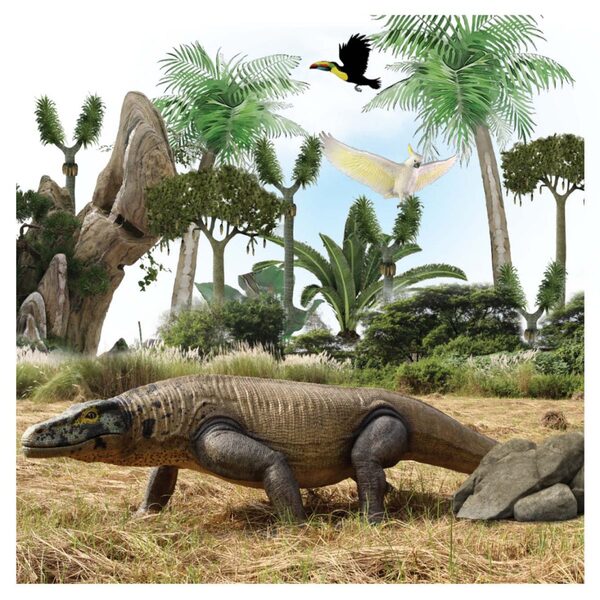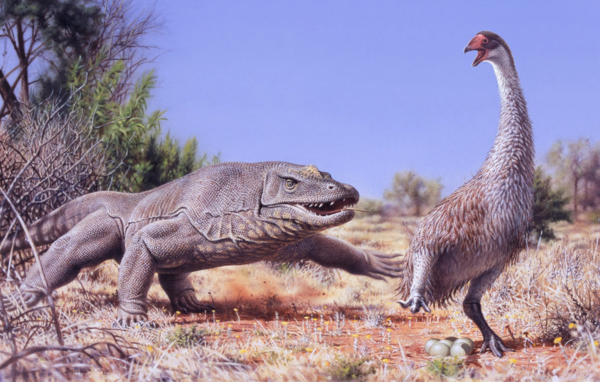In a time long before the modern world knew the fearsome Komodo dragon, there existed another terrifying predator that roamed the ancient Earth: the Red Crocodile (Crocodilus ruber), a prehistoric beast with a striking resemblance to the Komodo dragon. These enormous reptiles were not only fearsome hunters but also had an anatomy that left scientists puzzled and amazed. What set them apart from many of their contemporaries was the absurdly oversized heads they balanced on their muscular bodies—a feature that both defined their existence and fueled their dominance as apex predators.

The Red Crocodiles, as they were dubbed by paleontologists due to their striking reddish-brown coloration, were part of a now-extinct family of reptiles that lived during the late Cretaceous period, about 70 million years ago. These creatures could reach lengths of up to 30 feet (9 meters) and weighed over a ton. Despite their massive size, it was their enormous, grotesque heads that set them apart from anything else in their ecosystem.
Unlike modern-day Komodo dragons, whose bodies are proportionate to their heads, Red Crocodiles had disproportionately large skulls that seemed almost comically oversized compared to their bodies. Their heads were covered in thick, armor-like scales, and their jaws were packed with serrated teeth, capable of tearing through flesh and bone with ease. This oversized head was not merely a biological quirk—it was a powerful adaptation that allowed them to dominate their environment in ways other predators could not.
The biggest question scientists asked when the fossilized remains of Red Crocodiles were first discovered was: How did these creatures manage to survive with such massive heads? The skulls were so large and heavy that it seemed nearly impossible for them to support or maneuver effectively.
Research into their anatomy suggests that their thick, reinforced necks were key to their survival. These ancient creatures had evolved incredibly robust neck muscles and vertebrae, which helped them carry the immense weight of their heads. Their entire skeletal structure was designed to support this unique feature, making the Red Crocodile one of nature’s most bizarre but effective predators.
Furthermore, the Red Crocodile’s broad, powerful tail served as a counterbalance. Much like modern crocodiles and Komodo dragons, their tail was a critical part of their hunting strategy, used for balance and, in some cases, to deliver devastating strikes to prey. However, in the Red Crocodile’s case, the tail’s primary function was to offset the weight of its oversized head, allowing it to remain agile despite its seemingly cumbersome proportions.

Much like modern Komodo dragons, Red Crocodiles were apex predators in their environment, feared by all other creatures. Their massive jaws and crushing bite force meant they could bring down animals much larger than themselves, including prehistoric mammals, dinosaurs, and even aquatic creatures that ventured too close to shorelines.
Their large heads were not just for show. They served as biological battering rams, delivering bone-crushing bites that would shatter the skulls and spines of their prey. Fossil evidence shows that many of the animals in their habitat bore the scars of Red Crocodile attacks, with some skeletons revealing snapped bones and deep puncture wounds that could only have been made by the monster's oversized jaws.
The Red Crocodile also possessed a Komodo-like stealth, stalking prey with an eerie quietness for a creature of its size. It would ambush animals near water sources, lunging out with deadly precision, much like today’s crocodiles. But unlike modern reptiles, it could hunt and move over much larger distances thanks to its specialized anatomy.
The Red Crocodiles weren’t just effective hunters because of their size and strength—they were also highly intelligent. These ancient reptiles exhibited remarkable hunting strategies, sometimes working together in packs to take down large prey, much like wolves. This level of cooperation is rare in reptiles today, but it likely contributed to their dominance during the Cretaceous period.
The overdeveloped senses of the Red Crocodile also played a crucial role in their hunting prowess. Their large heads housed extraordinarily sensitive smell receptors that allowed them to detect prey from miles away, and their keen eyesight gave them an advantage when hunting during dusk or dawn. Like modern Komodo dragons, they used their long, forked tongues to "taste" the air and track prey with frightening accuracy.

For all their power and dominance, the reign of the Red Crocodile came to an abrupt end. Scientists speculate that climate change and shifting ecosystems, combined with competition from emerging species of large dinosaurs and mammals, led to their extinction. As the Cretaceous period ended and the world’s ecosystems underwent drastic changes, the Red Crocodile, with its immense body and need for abundant food, likely struggled to adapt.
Their massive heads, which had once been a key advantage in their survival, may have also become their downfall as resources grew scarcer. While smaller, more adaptable species could survive on limited food supplies, the Red Crocodile's colossal head and voracious appetite made it vulnerable to starvation in changing environments.
Although the Red Crocodile went extinct millions of years ago, its legacy can be seen in modern reptiles, particularly the Komodo dragon. The similarities between the two species—especially in their hunting techniques, social behavior, and physical features—have led many scientists to believe that the Komodo dragon is a distant descendant of these ancient giants.
The Komodo dragon’s terrifying hunting prowess and remarkable survival skills offer us a glimpse into the world that the Red Crocodile once ruled. As we study these modern-day monsters, we learn more about their ancient ancestors—creatures whose oversized heads and sheer power made them the undisputed kings of their era.
The Red Crocodile was an ancient, Komodo dragon-like creature that thrived in a time when the world was ruled by giants. With its absurdly large head, crushing bite force, and fearsome predatory skills, it was a dominant force in its ecosystem. While these creatures may no longer walk the Earth, their fossils remind us of the terrifying creatures that once roamed our planet—a chilling reminder that, in the distant past, the world belonged to monsters.
animal tags: Ancient-Komodo-Dragon
We created this article in conjunction with AI technology, then made sure it was fact-checked and edited by a Animals Top editor.